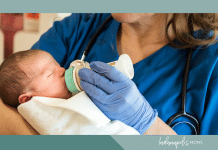 Like many expecting new moms, I embraced the resources we now have – endless apps to track week by week, Instagram accounts dedicated to each stage of pregnancy, and calendars that help you monitor your symptoms. For someone like myself who loves to research and prepare for things, I nerded out. When I found out I was having twins, this only increased. I skimmed all the recommended books and had a list of questions on my Notes app with each doctor visit. I had written before about how some of my excessive preparation tendencies had some negative sides. However, in this case, being as informed as possible potentially helped save my babies when the unexpected happened.
Like many expecting new moms, I embraced the resources we now have – endless apps to track week by week, Instagram accounts dedicated to each stage of pregnancy, and calendars that help you monitor your symptoms. For someone like myself who loves to research and prepare for things, I nerded out. When I found out I was having twins, this only increased. I skimmed all the recommended books and had a list of questions on my Notes app with each doctor visit. I had written before about how some of my excessive preparation tendencies had some negative sides. However, in this case, being as informed as possible potentially helped save my babies when the unexpected happened.
My husband and I had our 20-week anatomy scan and were elated when all looked well. At this point, each time I had a vaginal ultrasound done, the technician would measure my cervix and update me on the progress. Both babies were growing strong, and my cervix length was right around where they expected it to be (cervixes are ideally long and firm throughout most of your pregnancy). I had not thought much of it prior, but with the books I had read and each nurse providing me with positive feedback on my cervical length, I always made a note to ask.
By total chance and a fluke scheduling issue, our next appointment happened to fall only three weeks later, rather than four. I was being seen sooner than usual, but I didn’t mind – I was happy to have another ultrasound! The technician was fairly quick this time around and reported that all still looked great and on track. As she finished up and told me to get dressed, I asked, “how was my cervix measuring?” She hesitated for a moment and then obliged to check for me. After a long pause, she let me know that my cervix had shortened since my last visit three weeks earlier, and she wanted to show my doctor right away.
What happened next still feels like a fuzzy whirlwind in my mind. My OB let me know that my cervix had, in fact, shortened significantly and dangerously (also known as ‘incompetent’ or ‘short’ cervix’), and because of this, I was now at severe risk of preterm labor at only 23 weeks. My best option at this point was to undergo an emergency procedure called a ‘rescue cerclage.’ A cerclage is a single stitch used to close the cervix to prevent preterm labor. Physicians do not typically recommend this procedure beyond the 24-week mark of pregnancy, so time was of the utmost importance in our case. I was immediately sent downstairs to the MFM’s office, which confirmed the severe shortening. They promptly admitted me to the women’s hospital next door, where I would stay overnight for my surgery the next morning. There are risks with any procedure, and we discussed these at length with our MFM. With our history of the loss of our son, our doctors knew it was the best option for our twins and their chances of survival.
The procedure itself was quick, and we were thankfully discharged after spending another night in the hospital. I held my breath for the remainder of my pregnancy, hoping and praying that the cerclage was doing its job and keeping my babies in as long as possible. The next three months were hard and long, but I took it as easy as possible and tried my best to stay positive.
On December 2nd, 2020, my twins were born via scheduled c-section at 37 weeks and six days. My girls had made it full term and were born perfectly healthy with no NICU stay. Although stressful and scary, my husband and I are forever grateful for the cerclage procedure I had done. We also now know that this is likely in our future again if we choose to have more children. However, we would be able to get the procedure done earlier in pregnancy as a preventative measure. My hope for other expecting moms is to remind you to always advocate for yourself, speak up when you would like something specific checked, and inform yourself of your options if you should find yourself in similar circumstances.








